It’s time to dive into our list of the best betta fish tank mates; our swimming friends here can be picky when sharing their space.
Bettas are known as “Siamese Fighting Fish” for a reason!
Fortunately, there are several tank mates your betta will get along with.

Table of Contents
Tips on Betta Compatibility With Other Tank Mates

The temperament of bettas varies with each fish. Some betta fish are incredibly territorial, while others are so docile they get bullied by other fish.
Keep a separate hospital tank on standby if you need to remove an aggressive or injured fish from the community tank.
Betta fish owners usually keep a single betta. But, creating a betta fish community tank with suitable fish species is possible.
With Other Betta Fish

Male bettas are aggressive fish and should never be kept together without a tank divider.
We recommend at least a 20-gallon tank with a divider in the middle. This gives each male betta its own space. The dividers must be opaque so the two males cannot see each other.
A male and female betta may be kept together briefly for mating. However, the two fish must be separated after mating to prevent fighting.
Most female bettas may be kept together in a sorority tank as long as there is plenty of space.
An aquarium for betta sororities must be at least 30 gallons and contain no more than six females.
Start with 2-3 female betta fish and monitor for aggressive behaviors. If the females get along, you may add more females one at a time.
With Other Fish Species

A 20 or 30-gallon tank works well for a betta community tank, depending on how many fish you want to add.
Snails and shrimp are suitable companions in a smaller five or 10-gallon betta tank.
Keep more than one other fish with your betta to prevent a single fish from getting bullied.
Always quarantine new fish for 4-6 weeks to prevent the spread of diseases.
Choose fish with dull colors, short fins, and the ability to swim quickly. Bottom-dwelling fish, snails, and shrimp are also excellent choices.
Fill the tank with plants, caves, and other places to hide. These hiding places make your fish feel secure and prevent aggressive behaviors.
Dedicated Guides for Specific Tank Mates
Tetra Fish
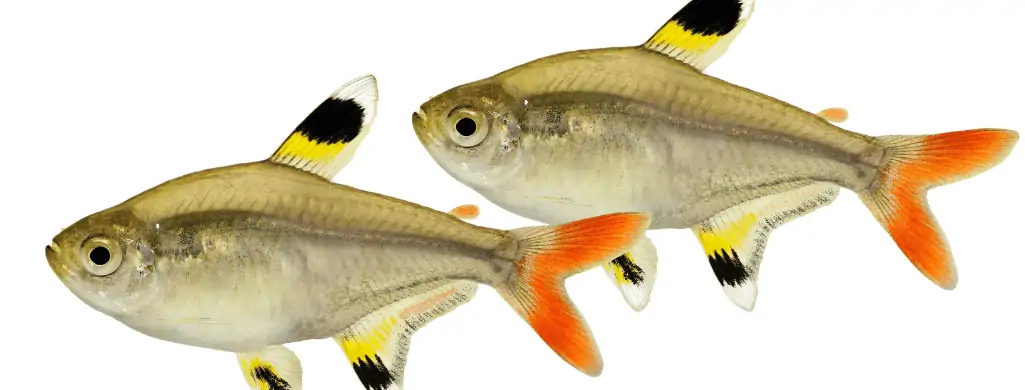
- Grown Size: 0.8-2″ inches
- Minimum Tank Size: 20 gallons
- Best Suited for: Female betta fish
Tetras are fast swimmers and come in a variety of colors.
Male bettas may get along with tetras, but their long fins make them a target for fin-nipping. Female bettas lack flowy fins, so they are better suited for living with tetras.
Brightly-colored tetras are more likely to be bullied by bettas, so keep this in mind.
Some varieties of tetras are more aggressive than others. However, group shoaling tetras in schools of at least 10-12 keeps them calm.
It is best to introduce a betta to an already established tetra tank to minimize aggressive behavior.
1. Neon Tetra
A neon tetra has a bright blue body with a red stripe on each side of its body.
This tetra variety grows up to 1.5″ inches long.
Despite the neon tetra’s bright colors, it is a fast swimmer, so it is safe around bettas.
2. Black Neon Tetra
The black neon tetra has a subdued coloring compared to the normal neon tetra.
Black neon tetras have transparent fins with a greenish-colored body and a black stripe along each side.
3. Rummy Nose Tetra
The rummy nose tetra has a silver body with clear dorsal, pectoral, and anal fins. The tail fin has black and white stripes.
Rummy nose tetras have a deep red coloring on their eyes and heads. These fish are usually 1-1.5″ inches long.
4. Ember Tetra
The ember tetra is one of the smallest tetra varieties at just 0.8″ inches long.
Use caution when placing ember tetras with a betta. Their small size and bright orange bodies make them a target for the larger betta fish.
Ensure your ember tetras are healthy before placing them with a betta. Ember tetras are very small, and sick ones are more likely to be eaten by bettas.
5. Cardinal Tetra
Cardinal tetras are very similar to neon tetras but are slightly larger.
They have bright red and blue stripes on their body and grow up to 2″ inches long.
6. Diamond Tetra
Diamond tetras are one of the largest tetra varieties, with a length between 2-2.4″ inches.
The body of a diamond tetra is a shiny golden, and the fins are a pale lavender hue.
Keep diamond tetras in schools of at least 8-10 to minimize nipping behavior.
7. Glowlight Tetra
The glowlight tetra has a translucent, silver-colored body with an iridescent red stripe on each side.
Glowlight tetras got their name because the red stripe on their bodies resembles a light bulb filament.
8. Golden Tetra
Golden tetras have silvery bodies with a gold hue.
The golden tetra has an average length of 1.5″ inches.
These fish require a well-maintained tank because they are prone to skin diseases.
Golden tetras detect sound waves in their bones, giving them acute hearing capabilities.
9. Silvertip Tetra
Use caution when keeping silvertip tetras with a betta. Silvertips are more aggressive than other tetra varieties.
If you notice aggressive behavior in your silvertip tetras, remove them from the betta tank.
In general, silvertip tetras are less aggressive in schools of 10 or more in a larger tank. A 20-gallon tank is adequate, but a 30-gallon tank is better.
Male silvertip tetras are a copper color, and the females are silver. Both sexes have white tips on the fins.
10. Blue Tetra
Blue tetras have iridescent blue bodies with transparent fins and grow up to 2″ inches long.
The blue tetra is a peaceful fish but may be slightly aggressive to smaller fish during feeding.
Monitor your blue tetras for fin nipping. This behavior is minimized when blue tetras are kept in schools of at least 10.
11. Red Eye Tetra
Despite their name, the eyes of red eye tetras are not entirely red. Only the top part of the iris is red, and the lower half is gray.
The body is iridescent gray with a splash of black on the tail fin.
Betta fish owners have mixed results with keeping red eye tetras in a community tank with their betta.
If you choose red eye tetras for a mixed tank with your betta, monitor the fish for aggressive behavior.
12. Pristella Tetra
Pristella tetras are also known as x-ray tetras because of their clear body.
The dorsal and anal fins have yellow, black, and white stripes with red on the tail fins. They grow up to 1.75″ inches long.
13. Black Phantom Tetra
Black phantom tetras have a muted gray body with a distinct black spot behind the gills. The black spot is surrounded by two white lines, resembling an eye.
The black phantom tetra grows to 1.75″ inches long and prefers a larger, heavily planted tank.
Black phantom tetras are generally not aggressive towards bettas. However, these fish often mock fights among themselves, which may stress a betta.
Again, there are mixed reviews on the overall temperament of the black phantom tetra.
Please proceed cautiously and monitor your fish for aggressive behavior when placing them with a betta.
14. Penguin Tetra
Penguin tetras have shiny, iridescent bodies with a think black striped running from the eye to the tip of the tail fins.
The penguin tetra is larger than other tetra varieties, growing up to 3″ inches long.
These fish need plenty of room to swim, so consider getting a 30-gallon tank. This gives them more room to explore without going into the betta’s territory.
15. Green Neon Tetra
The green neon tetra is a peaceful fish with a similar appearance to a regular neon tetra.
Green neon tetras have a more pronounced red body stripe with a thin turquoise stripe on top.
They are also tiny fish, growing to only 0.25″ inches long.
Be aware of sick green neon tetras, as a betta may eat them.
16. Head and Tail Light Tetra
Head and tail light tetras have silver bodies with distinctive copper dots on the head and tail.
These tetras grow up to 2″ inches long and require water parameters similar to bettas.
The head and tail light tetra is not known to nip fins. Even so, keeping these tetras with a female betta is better.
Rasbora Fish
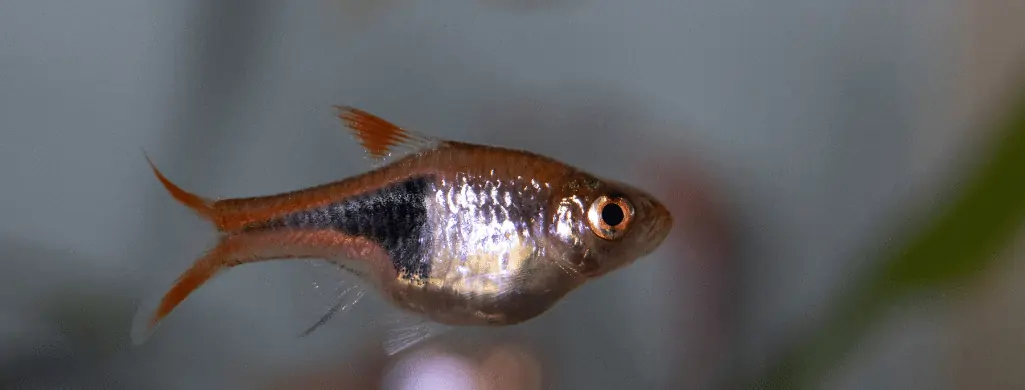
- Grown Size: 0.8-2″ inches
- Minimum Tank Size: 20 gallons
- Best Suited for: Either male or female betta fish
The rasbora is an excellent tank mate option for betta fish.
Rasboras are native to the same climate and habitat as bettas. Therefore, they do well in the same water temperatures and parameters as a betta tank.
Both fish species also have similar food requirements.
The rasbora is a schooling fish and does well in a group of 6-10 fish.
Provide ample hiding spots with aquatic plants and caves to make your rasboras feel secure.
Rasboras are part of the same fish family as danios and goldfish and come in many colors.
The rasbora is a peaceful fish, and its easy care requirements make it a good choice for beginners.
17. Harlequin Rasbora
The harlequin is the most popular variety of rasbora fish.
Harlequin rasboras have a shimmery red body with a black triangular marking near the tail fins.
These rasboras have a docile personality and are not known to nip at other fish.
18. Fire Rasbora
The fire rasbora is pale orange with red, orange, or yellow fins. These small fish are 1.5″ inches long.
Fire rasboras have a docile temperament and are best kept in schools of 6 or more.
While fire rasboras are brightly colored, they are still safe to keep with male and female bettas.
19. Lambchop Rasbora
Lambchop rasboras appear similar to harlequins but have a brighter orange color.
The fish gets its name from the black mark on its body, which resembles a pork chop.
Lambchop rasboras are very calm and get along well in community tanks with a betta.
20. Mosquito Rasbora
The mosquito rasbora, also known as the chili rasbora, is the smallest variety of this species.
Mosquito rasboras have an average size of just 0.6-0.8″ inches.
These peaceful fish get along well with other species. But due to their bright red bodies and small size, they are not always safe around a betta.
If there are plenty of aquatic plants and hiding spaces, mosquito rasboras may go unnoticed by a betta.
21. Blackline Rasbora
As their name suggests, blackline rasboras have a black stripe down the length of their silver bodies.
Blackline rasboras are slender and grow up to 2.5″ inches long.
These fish are happiest in schools of 8-10 and generally keep to themselves.
Endlers
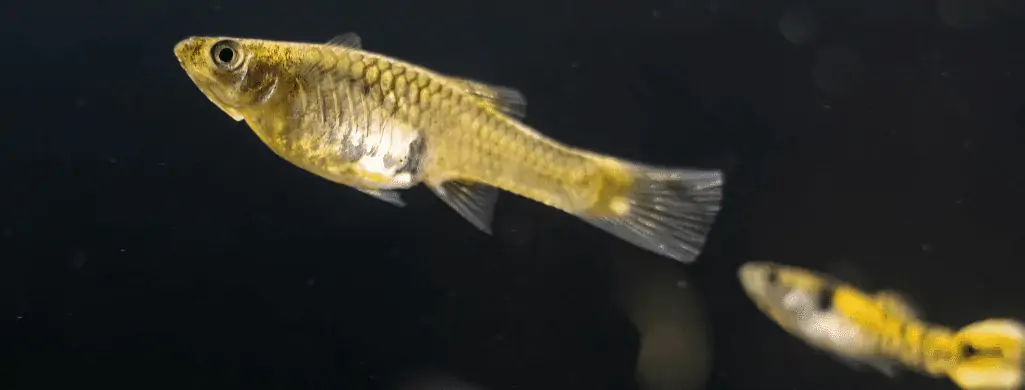
- Grown Size: 1-1.8″ inches
- Minimum Tank Size: 20 gallons
- Best Suited for: Either male or female betta fish
Endlers are great tank mates for bettas because they thrive in the same temperatures and water parameters.
An endler does not threaten a betta because it is not a flashy fish.
Endlers do not have distinct colors or flowy fins, and they are fast swimmers.
A betta is likely to ignore endlers, especially if there are plenty of aquatic plants and caves to hide in.
Many people assume endlers are guppies, but this is not entirely true.
Endlers often mate with guppies in a community tank, but a true endler is not related to guppies.
22. Black Bar Endlers
Black bar endlers are rare, so you will not likely find them at your local pet store.
Male black bar endlers are more colorful than females, with orange, green, and black splotches.
The black bar endler is not an aggressive fish and is not known to nip at other fish.
23. Lime Green Endlers
Lime green endlers are not as rare as black bars but have a similar appearance.
The main difference is lime green endlers have more green on their bodies.
Female lime green endlers are more suitable for betta fish tanks because they do not have flashy colors.
Female Guppy

- Grown Size: 1.2-2.4″ inches
- Minimum Tank Size: 20 gallons
- Best Suited for: Female betta fish
There is a reason only female guppies are mentioned here. Never put male guppies in the same tank as a betta.
Male guppies are brightly colored and have flowing fins. These bright colors trigger aggression in betta fish.
Female guppies lack fancy adornments and usually have a subdued coloring compared to males.
A female guppy is also less aggressive than a male.
Keeping your female guppies with a female betta is generally safe if the tank is large enough.
24. Female Guppy
Female guppies usually have pale gray or silver bodies. This is a stark contrast to the more vivid body colors of male guppies.
A female guppy also has short, triangular fins instead of long, flowy ones.
Guppies are schooling fish, so the females feel more secure in groups of 6 or more.
Nano Catfish
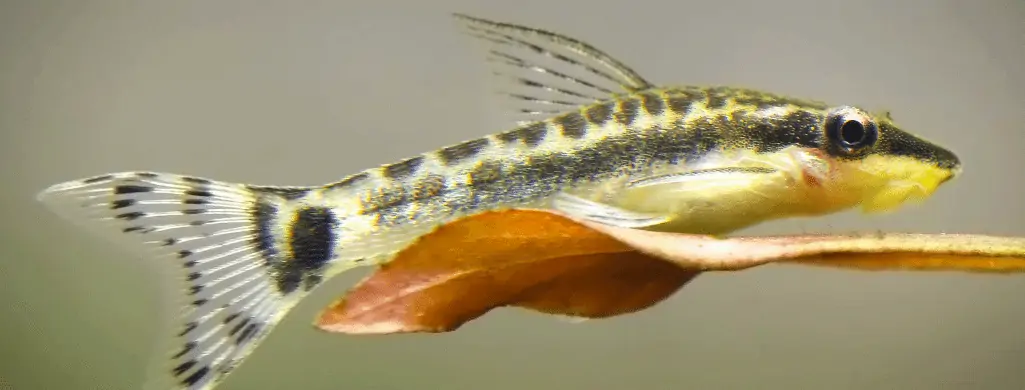
- Grown Size: 2-4″ inches
- Minimum Tank Size: 10 gallons
- Best Suited for: Either male or female betta fish
Nano catfish have the same traits as larger ones in a river, only much smaller.
These tiny catfish are perfect tank mates for bettas because they stay mainly on the bottom of the tank.
As a bonus, nano catfish clean algae off your tank’s aquarium gravel and glass sides.
Nano catfish mostly stay out of the way of bettas. This makes them suitable tank mates for male and female bettas.
25. Otocinclus Catfish
Otocinclus catfish are one of the most popular species for fish tanks. They are excellent cleaners and get along well with almost any fish species.
Avoid mixing your otocinclus catfish with large, aggressive fish species.
In the wild, otocinclus catfish live in shoals of thousands and are very social fish.
You may keep up to 6 otocinclus catfish in a 10-gallon tank and 10-15 in a 20-gallon tank.
Otocinclus catfish spend most of their time cleaning the glass or gravel in an aquarium.
Like bettas, otocinclus catfish occasionally swim to the surface to breathe air.
26. Glass Catfish
Glass catfish have transparent bodies with visible organs.
Unlike other nano catfish, glass catfish like to swim in the middle of the tank.
The glass catfish is also a shoaling fish. You may add up to 6 of them in a 30-gallon tank with a betta.
Glass catfish are very docile and will not attack your betta.
Provide plenty of aquatic plants and hiding places to help glass catfish feel safer.
27. Upside-Down Catfish
Upside-down catfish are one of the largest aquarium catfish varieties at over 4″ inches long.
Since upside-down catfish are large, you must have a 30-gallon tank to accommodate them.
A lone upside-down catfish will become anxious and prefers living in a group of 3-4 others.
The diet of upside-down catfish consists mainly of insects and larvae, but they eat algae as a supplement.
Dwarf Loaches
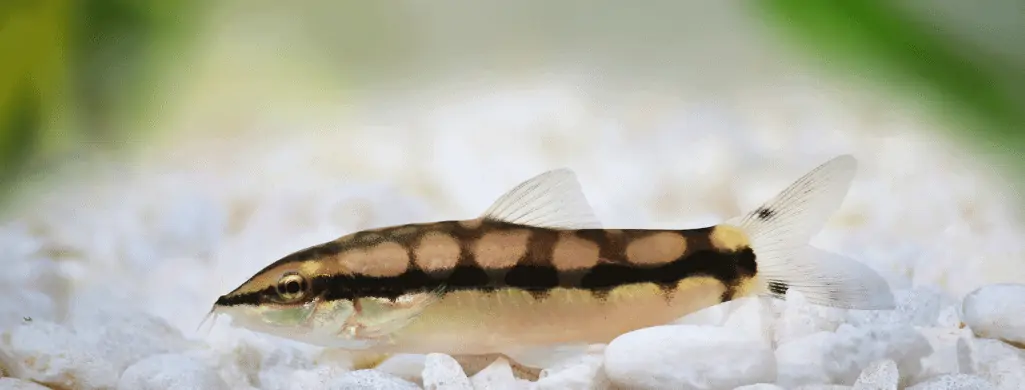
- Grown Size: 2-6″ inches
- Minimum Tank Size: 20 gallons
- Best Suited for: Either male or female betta fish
Dwarf loaches are another great tank cleaner to keep with your betta.
Most loaches are docile and keep to themselves, but some varieties are more aggressive than others.
A loach spends most of its time on the bottom of the tank. Therefore, they prefer to be in groups of 3-6 to feel more secure.
Do not keep loaches in the same tank as invertebrates, like snails or shrimp. Loaches are carnivores and will eat these tiny creatures.
28. Kuhli Loach
The kuhli loach is the most popular variety in a betta tank.
Kuhli loaches are excellent tank cleaners and lack fins for your betta to nip.
A kuhli loach’s diet consists of insects and protein-rich fish pellets.
The kuhli loach is very friendly to other fish species, including bettas.
29. Yoyo Loach
Yoyo loaches grow up to 6″ inches long, so you must have at least a 30-gallon tank to house them with your betta.
While yoyo loaches are friendly as long as 3 or 4 are together, we recommend monitoring them for signs of aggression toward your betta.
30. Zebra Loach
Zebra loaches grow up to 4″ inches long but are usually smaller.
The zebra loach has distinct stripes all over its body, except for the stomach.
Zebra loaches may nip at a male betta’s fins, so keeping them with a female betta is best.
Since zebra loaches stay on the bottom of the tank, it is easy for bettas to avoid them. However, monitoring the two species for signs of aggression to be safe is still wise.
31. Guntea Loach
The guntea loach grows up to 6″ inches long and resembles a freshwater eel.
Guntea loaches prefer to live in groups of at least three. A 30-gallon tank ensures there is enough room for them and your betta.
Like other loaches, gunteas stay close to the bottom of the tank and will not bother your betta.
Plecostomus (Pleco)
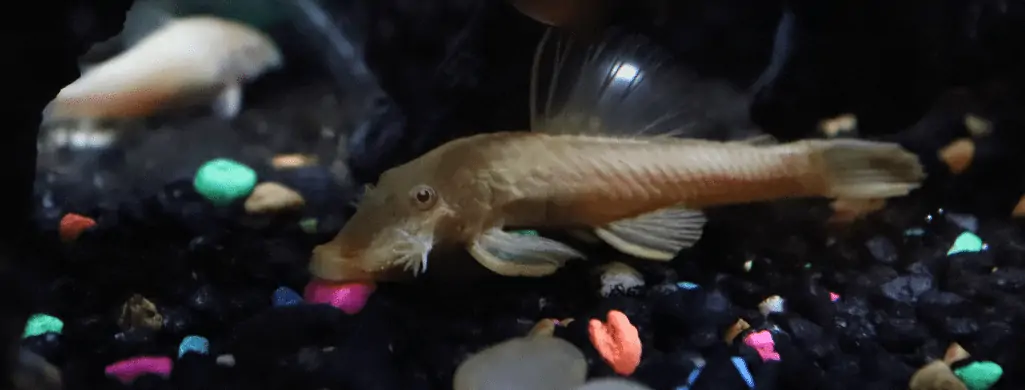
- Grown Size: 1.5-12″ + inches
- Minimum Tank Size: 20 gallons
- Best Suited for: Either male or female betta fish
The plecostomus, also known as the pleco, is a type of aquarium catfish with a sucker-shaped mouth.
Plecos have bone-plated bodies, and some species can breathe air.
Most pleco varieties stay small, while others grow more than a foot long.
The larger plecos require a tank size of 50-75 gallons. Always double-check the type of pleco you buy to avoid surprises later.
Like the smaller nano catfish, plecos are excellent tank cleaners.
32. Clown Pleco
Clown plecos are on the smaller side, with a length of 4.5″ inches.
One clown pleco will be comfortable in a 20-gallon tank with your betta. Multiple clown plecos require a minimum tank size of 30 gallons.
33. Bristlenose Pleco
The bristlenose pleco is the most common pleco kept in fish tanks.
Bristlenose plecos are shy and will avoid your betta during the day. However, they are more active at night when they are feeding.
A bristlenose pleco has an average length of 6″ inches, so you must have at least a 30-gallon tank.
34. Snowball Pleco
The snowball pleco is dark brown or black with white spots all over its body.
Snowball plecos grow up to 6″ inches long and are omnivores. However, they do not eat as much algae as other plecos, so do not expect them to be great tank cleaners.
35. Candy-Striped Pleco
The candy-striped pleco gets along well with most other fish species except for other bottom dwellers.
Candy-striped plecos are around 5.5″ inches long and do well in 20-gallon aquariums with a betta.
Unlike other plecos, candy-striped plecos feed primarily on driftwood and do not eat algae. This is something to keep in mind if you are interested in a tank cleaner.
Corydoras Fish (Cory)
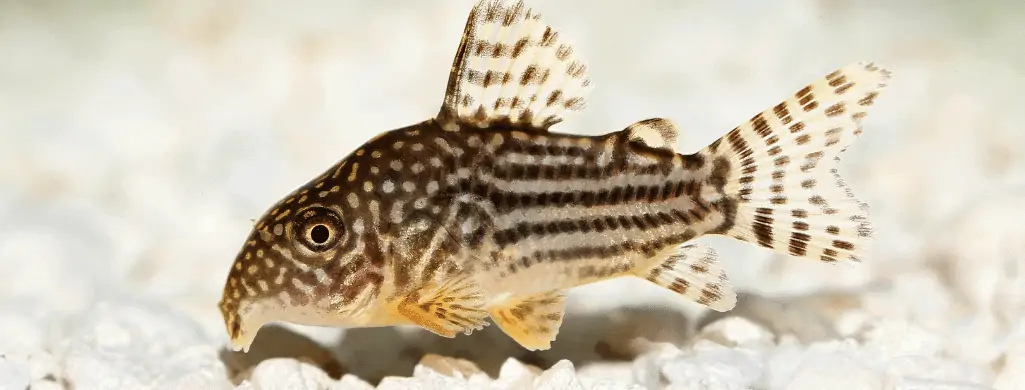
- Grown Size: 1-4″ inches
- Minimum Tank Size: 20 gallons
- Best Suited for: Either male or female betta fish
Corydoras fish are another member of the catfish family.
The cory fish is an excellent tank cleaner, and their friendly personality makes them suitable for betta tanks.
Cory fish stay smaller than other aquarium catfish species. The average length of a cory is around 4″ inches.
These fish have bony plates along their bodies and horizontal pectoral fins. These horizontal fins allow them to lay comfortably on the tank’s bottom.
Since cory fish are social, it is best to keep them in groups of 4-6.
Cory fish need adequate hiding spaces and consistent tank parameters to stay healthy.
36. Panda Cory
The panda cory has a black and white body color similar to a giant panda bear.
A panda cory is about 2″ inches long, so you will need a 20-gallon tank for a school of six.
37. Pygmy Cory
The pygmy cory is one of the smallest cory varieties, with a maximum length of 1″ inch.
Pygmy cories use their intestines for breathing air occasionally.
Since they are so small, keep pygmy cories in groups of 4-6 to prevent bullying from bettas.
Various aquatic plants and rocks provide your pygmy cories with hiding spaces to feel safe.
38. Albino Cory
Albino cories have a unique appearance with white bodies and pink or light red eyes.
These fish are active during the day and will clean algae from the tank substrate and glass.
Supplement an albino cories diet with softened pellets or fish flakes.
Snails

- Grown Size: 0.25-2″ inches
- Minimum Tank Size: 5 gallons
- Best Suited for: Either male or female betta fish
Snails are wonderful tank mates for small betta fish aquariums.
They are good tank cleaners and will not interfere with your betta fish.
The only downside to snails is their prolific breeding habits. If you are not careful, your entire tank will become overrun with snails.
Fortunately, only a few snail species can reproduce in freshwater tanks.
Having a lot of snails seems like a good idea, but the average betta tank does not produce enough algae to sustain more than one or two.
39. Mystery Snail
Mystery snails are suitable for beginners because of their hardy nature and easy-care requirements.
These snails are very active and are available in a variety of colors.
A mystery snail requires calcium in its diet. So if you have soft water in your tank, you may need to add a calcium supplement for them.
With an average size of 1.5-2″ inches, we recommend only one mystery snail for a 5-gallon tank.
40. Nerite Snail
Nerite snails are tiny, with a maximum length of 1″ inch.
A lid is essential for your tank, as nerite snails are very good at escaping.
The most popular nerite snail is the zebra snail, which has a striped shell.
These snails do not reproduce in freshwater but may lay eggs when you first get them.
The eggs rarely hatch, but if you see them on the underside of plant leaves, scrape them off just in case.
Nerite snails prefer a higher pH than bettas, so use a test kit to ensure your water has a pH of at least 7.
A pH of 7 is tolerable for your betta and the nerite snail.
41. Ramshorn Snail
Ramshorn snails are active but not the best cleaners on this list.
They come in a variety of colors and get along well with bettas.
Unfortunately, the ramshorn snail can reproduce in freshwater. Therefore, remove eggs as soon as you see them to avoid being overrun with snails in your tank.
42. Assassin Snail
If you want to control the snail population in your tank, the assassin snail is the best option.
Assassin snails eat other snails as well as algae.
These hardy snails may also survive on algae and plants when there are no other snails to eat.
Shrimp
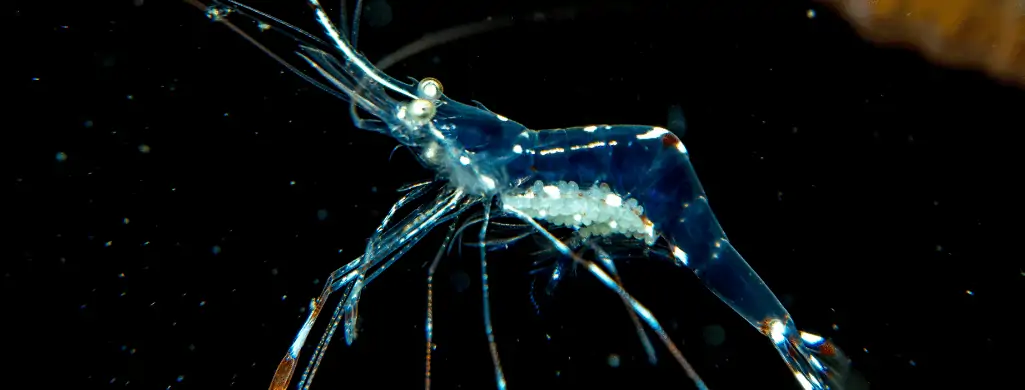
- Grown Size: 0.5-2″ inches
- Minimum Tank Size: 5 gallons
- Best Suited for: Either male or female betta fish
Shrimp are easy to care for and do well in a smaller tank.
Like snails, shrimp are a fun way to get rid of algae in your betta fish aquarium naturally.
Bettas usually do not bother shrimp, but be aware of any aggressive tendencies in your fish.
43. Ghost Shrimp
Ghost shrimp, also known as glass shrimp, have translucent bodies.
They are larger than many aquarium shrimp species, growing up to 1.5″ inches long.
Adult ghost shrimp will breed, but your betta will likely eat the babies to help control the population.
44. Cherry Shrimp
Cherry shrimp are usually a bright pink but come in other varieties.
Only female cherry shrimp are brightly colored, so it is easy to tell them apart from the males.
Female cherry shrimp are also larger than males at about 1″ inch long. Therefore, they are prone to betta attacks due to their small size, but they are also prolific breeders.
45. Amano Shrimp (Algae Eating Shrimp)
Amano shrimp are excellent tank mates and cleaners.
At 2″ inches long, they are also one of the largest aquarium shrimp varieties.
The Amano shrimp is gray with stripes and dots, so it doesn’t attract much attention from a betta.
Dwarf Crayfish
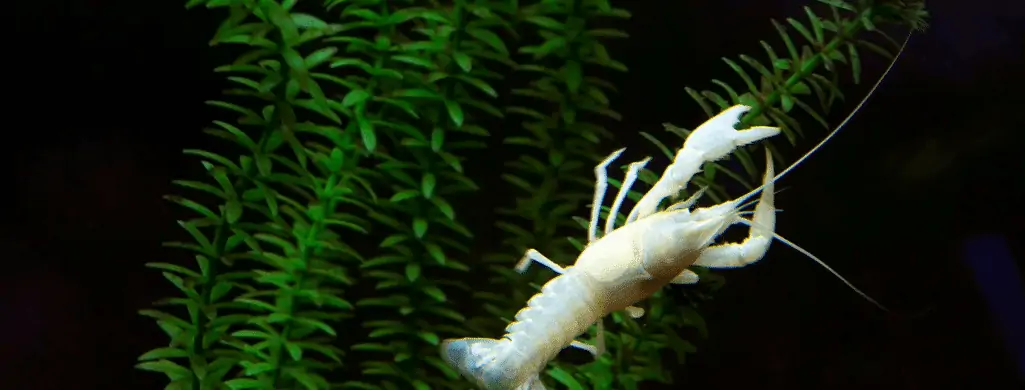
- Grown Size: 1-1.5″ inches
- Minimum Tank Size: 10 gallons
- Best Suited for: Either male or female betta fish
The key to successfully keeping dwarf crayfish with your betta is providing plenty of room for them.
Crayfish generally keep to themselves, but a small tank makes it difficult to separate them from your betta.
A short-finned betta is less likely to get nipped by a crayfish’s claws.
Dwarf crayfish are not aggressive and usually find a place to hide rather than fight. So provide lots of hiding places like caves and aquatic plants for your dwarf crayfish.
46. Mexican Dwarf Crayfish
A Mexican dwarf crayfish is tan or brown in the wild. However, with selective breeding, these crayfish have developed an orange color in captivity.
This coloring makes the Mexican dwarf crayfish look like a tiny lobster.
This species of dwarf crayfish is on the endangered list and may be challenging to find.
47. Brazos Dwarf Crayfish
Brazos dwarf crayfish are a bit smaller than the Mexican dwarf crayfish.
The Brazos dwarf crayfish is usually gray or tan, but there are also blue varieties.
These crayfish have a docile personality but may go after any ghost shrimp in the tank.
Molly Fish (Shortfin)

- Grown Size: 3-4.5″ inches
- Minimum Tank Size: 30 gallons
- Best Suited for: Either male or female betta fish
Mollies are peaceful fish and get along well with bettas.
Since mollies come from brackish water, a low dose of aquarium salt in the tank may be necessary.
Adding three parts per thousand of aquarium salt to the tank will benefit your mollies and not harm your betta.
Mollies are schooling fish and prefer to be kept in groups of 6-8.
A molly fish is larger than a betta, so you do not have to worry about it getting bullied.
48. Black Molly
The black molly is the most common color of this species.
Black mollies are great for betta tanks because their dull coloring won’t attract the attention of your betta.
A black molly grows 3″ inches long, smaller than other molly varieties.
African Dwarf Frog
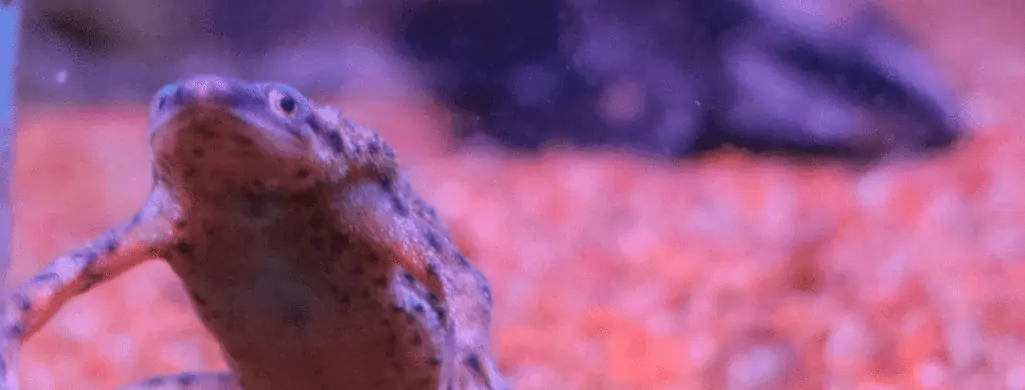
- Grown Size: 2.5″ inches
- Minimum Tank Size: 10 gallons
- Best Suited for: Either male or female betta fish
The African dwarf frog has a docile personality and is a great tank mate for a betta.
It would be best to feed your African dwarf frog sinking pellets so it does not have to compete with the betta for food.
African dwarf frogs prefer to stay in groups. If you want more than two frogs, we advise a 20-30-gallon tank for more space.
An African dwarf frog needs to breathe air, so ensure your tank is not too deep.
Add another substrate layer if your frog has problems getting to the surface.
49. African Dwarf Frog
African dwarf frogs have drab coloring, so they are unlikely to be harassed by your betta.
Their color ranges from olive green to light brown with black spots.
The diet of an African dwarf frog consists mainly of brine shrimp, bloodworms, and sinking fish pellets.
African dwarf frogs have gills when they are young but develop lungs as adults.
Incompatible Tank Mates for Betta Fish
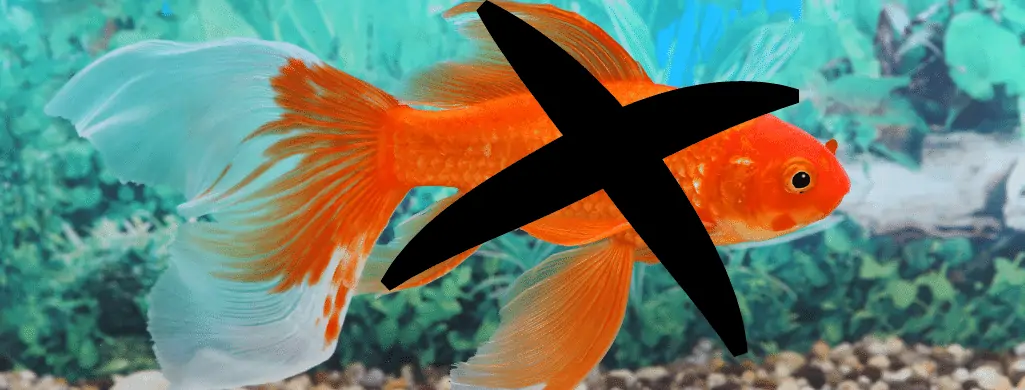
We have covered the best tank mates for your betta fish, but there are several to avoid.
1. Goldfish
It is challenging for a goldfish to survive in a betta tank. They prefer much cooler temperatures and will become overheated.
The bright colors and flowy fins of a goldfish also make it a target for a betta to attack.
2. Cichlids
Cichlids are extremely aggressive fish. This fish sees your betta as a threat and will not hesitate to attack.
3. Gouramis
Betta fish and gouramis are too much alike to be tank mates. These two fish will constantly fight over territory until one is dead.
4. Tiger Barbs
Although their water parameters are similar, tiger barbs and bettas cannot be kept in the same tank. Tiger barbs are fin nippers and will cause significant injury to your betta.
5. Chinese Algae Eaters
Chinese algae eaters should not be confused with Siamese algae eaters. Chinese algae eaters are highly aggressive and have been known to attack the eyes of other fish.
6. Dwarf Pea Puffer
Dwarf pea puffers are incredibly aggressive and will eat your betta’s fins. This often results in the betta’s death.
7. Rainbow Shark
Mixing a rainbow shark and a betta in the same tank is a recipe for disaster. Both fish are territorial and will constantly fight.
8. Axolotl
Axolotls are cute but not good tank mates for a betta. Young axolotls will get picked on, and the adults will eat your betta.
9. Danios
Danios are extremely active and will nip at your betta’s fins. Some will say these two species make great tank mates, but we do not recommend them.
10. Cherry Barbs
Like the tiger barb, the cherry barb is a fin nipper. The cherry barb has a docile temperament, but there is no guarantee it will not injure your betta.
Avoiding the risk and choosing a better tank mate for your betta is best.
11. White Cloud Mountain Minnow
White cloud mountain minnows get along with bettas just fine, but tank parameters are the issue.
The white cloud mountain minnow prefers much cooler temperatures. Therefore, this fish will be very stressed and overheated in a warm betta tank.
12. Clown Loach
Clown loaches get along with bettas, but the tank parameters are an issue.
A clown loach prefers swift currents, which is much different than the calm waters of a betta tank setup.
Clown loaches also grow larger than 12″ inches and like to be in groups of at least four. This requires a 50 to 100-gallon tank, and it won’t be easy to maintain the water parameters a betta needs.
Since they are so large, a clown loach may even see your betta as a snack if it gets hungry enough.
13. Malaysian Trumpet Snail
Malaysian trumpet snails grow to 6″ inches long, but this is not the main reason to avoid them.
These snails are considered pests to most fish keepers.
The Malaysian trumpet snail quickly reproduces and is known to dig up plants and disturb the tank.
14. Dawn Tetra
Dawn tetras have silvery bodies and black fins. These fish grow between 1.5-1.75″ inches long.
Unfortunately, dawn tetras are highly aggressive and unsuitable for keeping with bettas or other fish species.
15. Colombian Tetra
Colombian tetras are aggressive, so they are not recommended in tanks with a betta or smaller fish.
These tetras are notorious fin nippers, and they are quick to attack.
Get The Right Tank Mates For Your Betta
Betta fish are solitary creatures and do not get lonely in a tank alone.
When fish owners add tank mates to their betta setup, it is usually for their enjoyment.
Still, tank mates like snails and cories are helpful as tank cleaners and do not bother bettas.
If you are considering tank mates for your betta, it is crucial to do your research.


